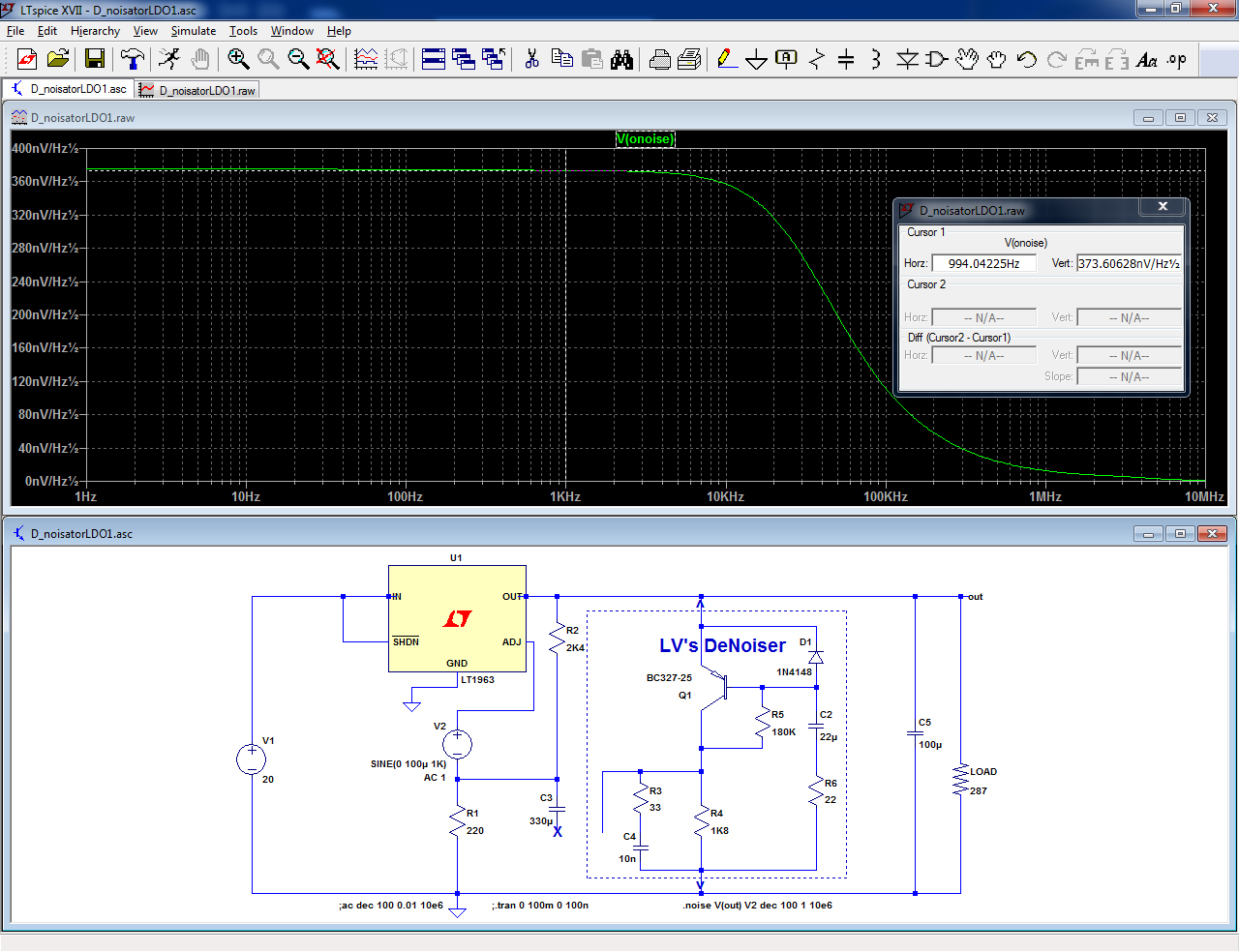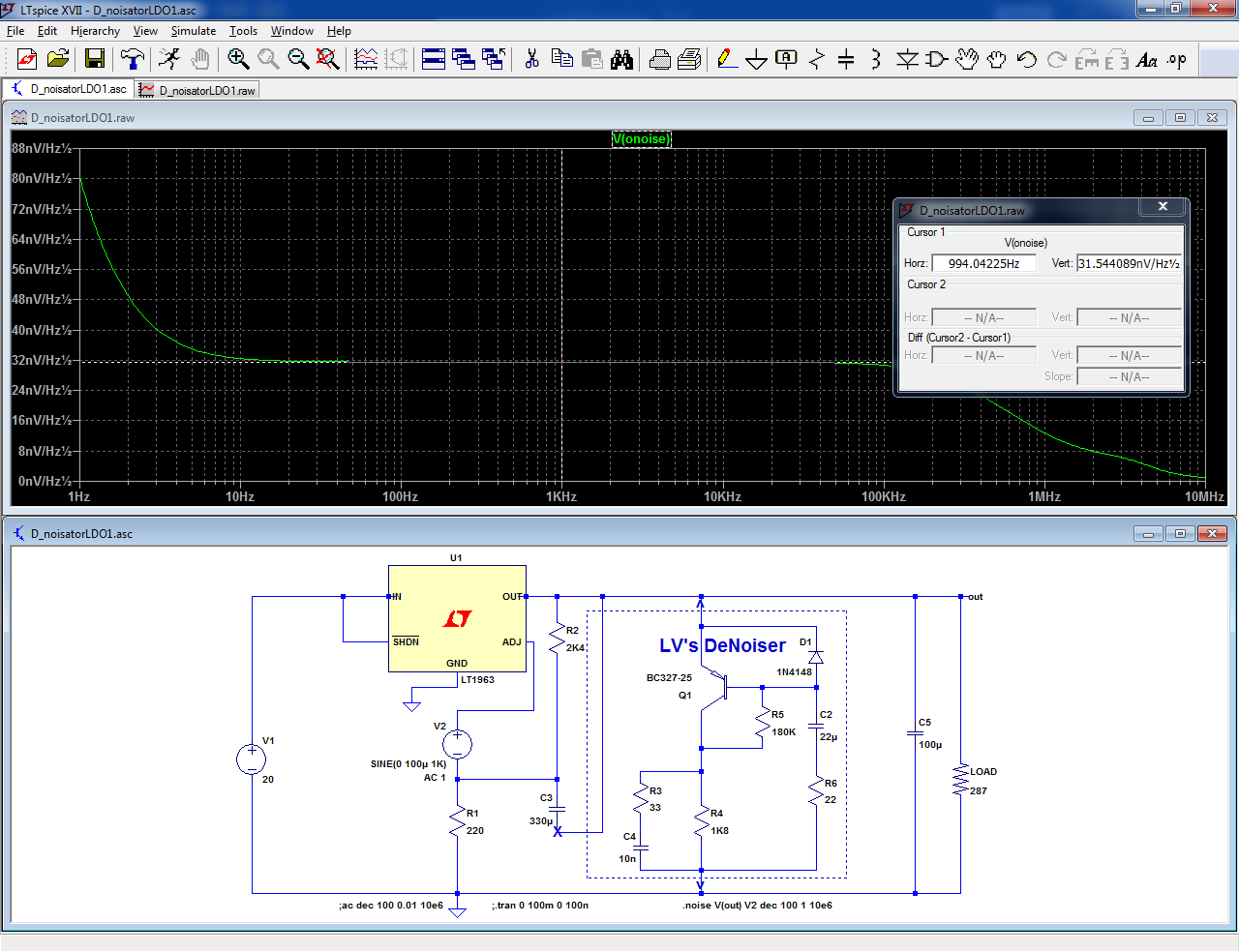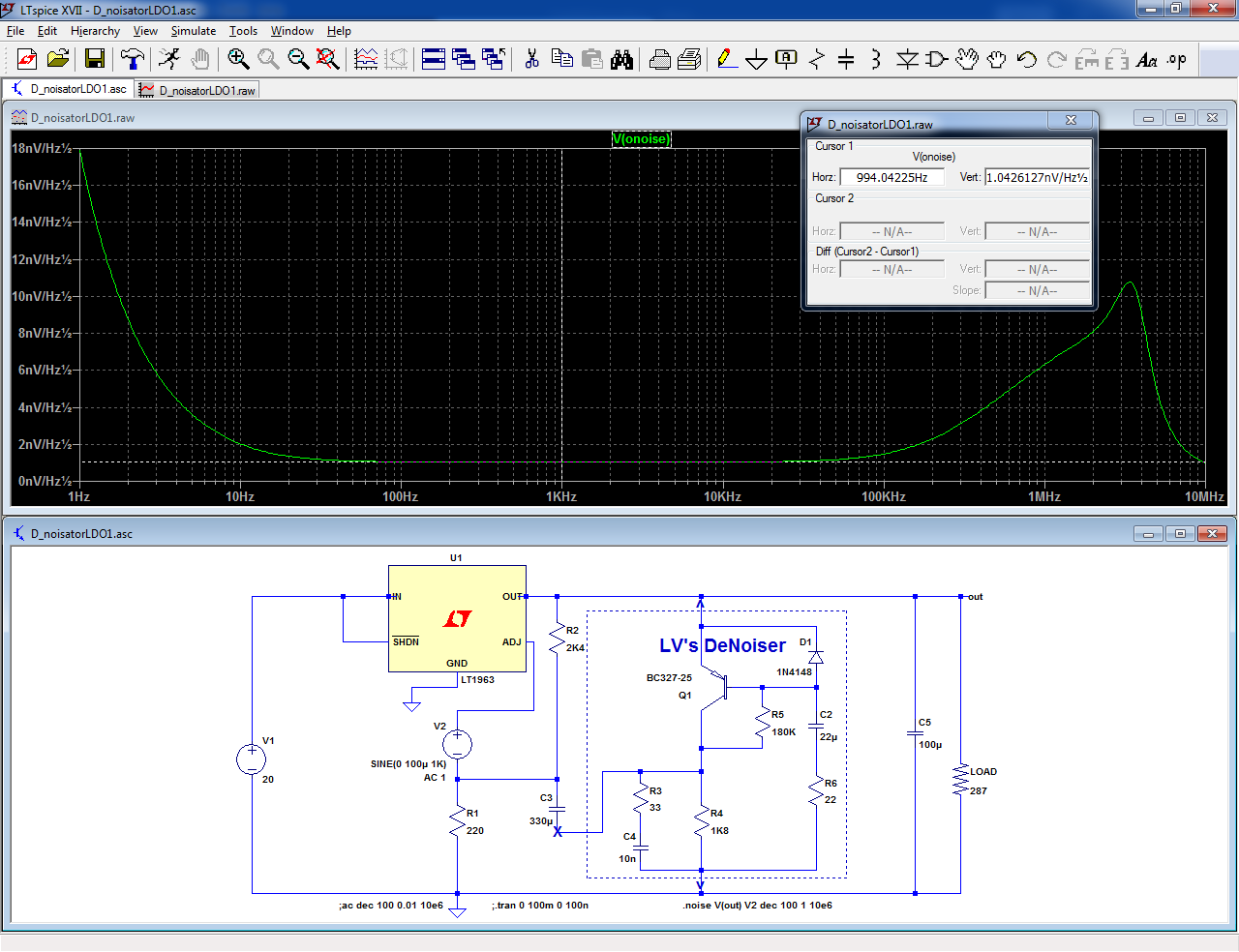Well, I started reading the thread again since the beginning, and perceived that Elvee only started using the command .noise in the simulation in
https://www.diyaudio.com/community/...grade-any-317-based-v-reg.331491/post-5856939
with the LT1963, whose model does seem to include noise modelling capacity.
When there's noise results from the Denoiser and NoNoiser it seems to come from actual LNA measurements.
I'm still in page 4 and I will continue looking for an actual .noise command on Elvee's regulators, but my guess is I won't find any. Am I right?
https://www.diyaudio.com/community/...grade-any-317-based-v-reg.331491/post-5856939
with the LT1963, whose model does seem to include noise modelling capacity.
When there's noise results from the Denoiser and NoNoiser it seems to come from actual LNA measurements.
I'm still in page 4 and I will continue looking for an actual .noise command on Elvee's regulators, but my guess is I won't find any. Am I right?
Probably, and for a very good reason: the .noise sim is not ideally suited to regulators, and models like the RH117 simply have no noise included..noise command on Elvee's regulators, but my guess is I won't find any. Am I right?
Even in models including noise, you cannot use the "normal" method to pinpoint the noise of the component: you cannot click on it like say a resistor or a transistor. If you look at the output, you will see noise, but it is the aggregated value of all possible contributors.
It is possible to isolate the regulator: to do that, you need to append the statement "noiseless" to all other components values; possible, but a bit clunky.
It is also why I included an artificial noise source in the sims: it is very crude and brutal, but it lets you see the effect of the noise correction vs frequency.
I have tested a Banggood regulator vs. a Motorola one: they look like perfect clones, denoised or not: stability is the same, noise is the same etc. The Bang reg has a ST logo, but I don't believe one second that it originates from ST. It is a copy, but a perfect one.
If you don't use it close to its 1.5A limit, I foresee no problem. The situation might be different for clones of other origin
Well, that is certainly very useful information, and a very clear one.
Which is the artificial noise source you include in the sims? My guess is it's related to the psrr, which was the first curve in page one.
Considering you were presenting a project called "denoiser", it would have been more logic to show a noise curve to compare with others. Then another project: a NoNoiser. And no noise curves.
The LT1963 was the only device that allowed you to simulate noise and then compare the results with measurements.
Which is the artificial noise source you include in the sims? My guess is it's related to the psrr, which was the first curve in page one.
Considering you were presenting a project called "denoiser", it would have been more logic to show a noise curve to compare with others. Then another project: a NoNoiser. And no noise curves.
The LT1963 was the only device that allowed you to simulate noise and then compare the results with measurements.
I think it's V2 from the schematic Elvee posted in his very first post on this thread.Which is the artificial noise source you include in the sims?
OK, so I have to give up on the possibility of having any idea on how noise (or lack of it) is actually being affected by the Denoizator or the NoNoiser if I don't have the tools to measure it, like LNA? OK.
I made some measurements for the original Denoisator and so did a few other people. There's a Denoisator measurement thread as well. Elvee also measured both Denoisator and NoNoiser, their noise levels are already known.
Using V2, that's exactly what you can do; you cannot get the absolute value, just the improvement brought by the denoiserOK, so I have to give up on the possibility of having any idea on how noise (or lack of it) is actually being affected by the Denoizator or the NoNoiser if I don't have the tools to measure it, like LNA? OK.
But there doesn't seem to be much difference between BC337 and ZTX851 in LTSpice, 1dB if that. It isn't the complete picture but good for general idea.
Good to know about LTSpice data for transistors not being so according to reality. Is there any PNP complementary to ZTX851?
ZTX951. I would add that almost all measurements at this level of noise are hard to accurately make. Relative measurements at this level are easier, absolute values are VERY hard.
No I mean you can't judge the final noise of the regulator output only by that V2 signal attenuation. You do get an attenuation value for the LM317 noise but there's also the BJT's noise in the mix.Good to know about LTSpice data for transistors not being so according to reality. Is there any PNP complementary to ZTX851?
For high gain designs, like nonoiser or dienoiser, the transistor performance totally dominates the picture
I'm aware of that, and I haven't given up on building the Denoisator.I made some measurements for the original Denoisator and so did a few other people. There's a Denoisator measurement thread as well. Elvee also measured both Denoisator and NoNoiser, their noise levels are already known.
Any news about updated boards and tests?Yes I did, you can find the latest published ones here:
https://www.diyaudio.com/community/...grade-any-317-based-v-reg.331491/post-7090788
But I just made some small revisions to them, ordered them and waiting to measure them before I release the new files.
We are both working on the measurement system. When we get that fixed, we will bring some stuff forward.
Elvee, why did you use a PNP Denoiser with the LT1963? Would an NPN work as well? Would there be any difference?By "poor man's denoiser" I meant the bypass cap.
Since the LT1963 has a reliable model, it is possible to simulate the noise performance of all the options.
First, the plain vanilla regulator circuit, with just the two resistors in circuit:

373nV/√Hz
Then, the poor man's denoiser (bypass cap):

31.5nV/√Hz
And finally, the complete denoiser in its full, glorious splendor:

1.04nV/√Hz
This has been explained at length earlier. To summarize, regulators come in two varieties: one, like the 317 have their output as reference terminal, and the others use the GND. To keep the feedback negative, a phase inversion is required, and this is most easily achieved by using a transistor of the opposite polarity
Hello everyone,
Congratulations on your contributions!!!
I'm interested in using the denoiser Diego's version with BC550BP et Trimpot (post 2475)
https://www.diyaudio.com/community/...grade-any-317-based-v-reg.331491/post-7090971
I did the simulation in Ltspice with BC547c (the one I have available at home) and it seems to work by adjusting the trimmer for low VCE.
So a negative version with 337 would be possible?
i tried with Ltspice using a BC557c but not sure about the result.
Sorry but I'm not that expert (for now).
Best Regards
Dimitri
Congratulations on your contributions!!!
I'm interested in using the denoiser Diego's version with BC550BP et Trimpot (post 2475)
https://www.diyaudio.com/community/...grade-any-317-based-v-reg.331491/post-7090971
I did the simulation in Ltspice with BC547c (the one I have available at home) and it seems to work by adjusting the trimmer for low VCE.
So a negative version with 337 would be possible?
i tried with Ltspice using a BC557c but not sure about the result.
Sorry but I'm not that expert (for now).
Best Regards
Dimitri
- Home
- Amplifiers
- Power Supplies
- D-Noizator: a magic active noise canceller to retrofit & upgrade any 317-based VReg